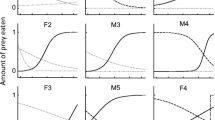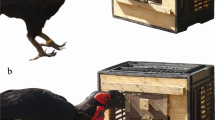Abstract
The wood mouse Apodemus speciosus can consume the hard-walled walnut species Juglans ailanthifolia. The mice gnaw holes on two sides of the shell and then pick the meat from the holes. However, not all mice are able to eat these walnuts, because the shells are extremely hard and the process is labour-intensive. To consume all of the meat it is more efficient to eat from holes on the raphe than to attempt to eat from other parts of the shell. We examined the effect of experience on the walnut-feeding skills of mice in the field. Feeding behaviours were compared among mice from habitats with and without walnut trees. Mice from habitats with walnut trees tended to consume nuts more efficiently than mice from habitats without walnut trees. We also observed the feeding behaviour of mice in an experimental area into which walnuts were artificially placed over a period of one year. This manipulation increased the proportion of mice that were able to eat nuts frequently and efficiently. Therefore, the walnut-feeding skills of mice improved with experience. Because individual mice acquired efficient feeding during the 14-day period of walnut conditioning, trial-and-error learning may be an important mechanism contributing to this behaviour.




Similar content being viewed by others
References
Abe H, Ishii N, Kaneko Y, Maeda K, Miura S, Yoneda M (1994) A pictorial guide to the mammals of Japan (in Japanese). Tokai University, Tokyo
Ainser R, Terkel J (1992) Ontogeny of pine cone opening behaviour in black rats, Rattus rattus. Anim Behav 44:327–336
Galef BG Jr (1980) Diving for food: analysis of a possible case of social learning in wild rats (Rattus norvegicus). J Comp Physiol Psychol 94:416–425
Galef BG Jr (2004) Approaches to the study of traditional behaviors of free-living animals. Learn Behav 32:53–61
Galef BG Jr, Giraldeau LA (2001) Social influences on foraging in vertebrates: casual mechanisms and adaptive functions. Anim Behav 61:3–15
Gandolfi G, Parisi V (1973) Ethological aspects of predation by rats, Rattus norvegicus (Berkenhout), on bivalves, Unio pictorum L. and Cerastoderma lamarcki (Reeve). Boll Zool 40:69–74
Kato J (1985) Food and hoarding behavior of Japanese squirrels. Jpn J Ecol 35:13–20
McFarland D (1981) The Oxford companion to animal behaviour. Oxford University Press, Oxford
Miguchi H (1993) Ecological features of seed dispersion by rodents. In: Kawanabe H, Washitani I, Ohgushi T (eds) Interaction of animals and plants (in Japanese). Heibonsha, Tokyo, pp 236–253
Muñoz A, Bonal R (2008) Seed choice by rodents: learning or inheritance? Behav Ecol Sociobiol. doi:10.1007/s00265-007-0515-y
Parisi V, Gandolfi G (1974) Further aspects of the predation by rats on various mollusc species. Boll Zool 41:87–106
Smith CC, Follmer D (1972) Food preferences of squirrels. Ecology 53:82–91
Tamura N (1998) Forest type selection by the Japanese squirrel, Sciurus lis (in Japanese). Jpn J Ecol 48:123–127
Tamura N (2001) Walnut hoarding by the Japanese wood mouse, Apodemus speciosus Temminck. J For Res 6:187–190
Tamura N, Hayashi F (2008) Geographic variation in walnut seed size correlates with hoarding behaviour of two rodent species. Ecol Res. doi:10.1007/s11284-007-0414-8
Tatsukawa K, Murakami O (1976) On the food utilization of the Japanese wood mouse Apodemus speciosus (Mammalia: Muridae) (in Japanese). Physiol Ecol 17:133–144
Terkel J (1996) Cultural transmission of feeding behavior in the black rat (Rattus rattus). In: Heyes CM, Galef BG Jr (eds) Social learning in animals: the roots of culture. Academic, San Diego, CA, pp 17–47
Weigl PD, Hanson EV (1980) Observational learning and the feeding behavior of the red squirrel Tamiasciurus hudsonicus: the ontogeny of optimization. Ecology 6:213–218
Zar JH (1996) Biostatistical analysis, 3rd edn. Prentice Hall, Upper Saddle River, NJ
Zohar O, Terkel J (1996) Social and environmental factors modulate the learning of pine-cone stripping techniques by black rats, Rattus rattus. Anim Behav 51:611–618
Acknowledgments
The authors thank Y. Ino, T. Suzuki, and T. Kusano for discussions of various aspects of this study, and the staff of the Tama Forest Science Garden for their valuable support in the field investigations. The capture of mice was permitted by the Tokyo Metropolitan and Shizuoka Prefectural Governments. All procedures were approved by the Tokyo Metropolitan University Animal Ethics Committee.
Author information
Authors and Affiliations
Corresponding author
About this article
Cite this article
Takechi, R., Tamura, N. & Hayashi, F. Improved walnut-feeding skills with experience in wood mice, Apodemus speciosus . J Ethol 27, 83–89 (2009). https://doi.org/10.1007/s10164-008-0087-y
Received:
Accepted:
Published:
Issue Date:
DOI: https://doi.org/10.1007/s10164-008-0087-y




